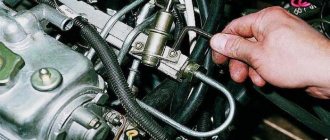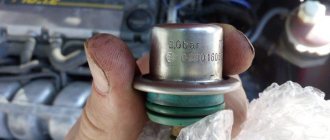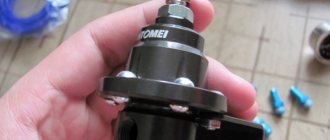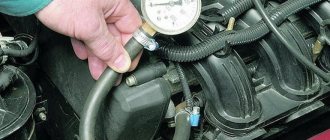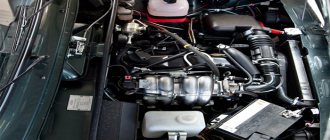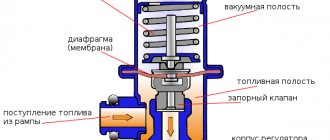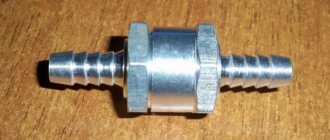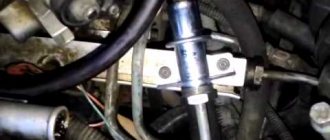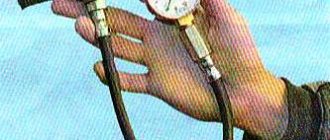The fuel line and the injector ramp that supplies the engine injectors operate under a pressure of about 3 bar. Since gasoline is supplied by an electric pump, the system uses a special valve that limits the fuel pressure. Otherwise, the nozzles will leak and the engine will choke on the over-enriched mixture. To avoid problems with fuel supply, you need to promptly diagnose the signs of a malfunction of the fuel pressure regulator (abbreviated as RTD) and know how to eliminate it.
The role of the fuel regulator in the car system
At different engine operating modes, it is necessary to create the appropriate fuel pressure in the fuel system.
To implement this task in practice, a special pressure regulator is used. It is used in injection engines, where the correct operation of the engine depends on the accuracy of the injection parameters. When the governor is faulty, the engine runs unevenly, acceleration times are increased, and in some cases power can be significantly reduced. So, for example, if the amount of air coming from the manifold remains unchanged, and there is more fuel than necessary, the air-fuel mixture will not ignite or will not burn completely.
Even if in this mode the electronic control unit shortens the injector opening interval, it will not be possible to completely compensate for the excess fuel pressure. This will lead to interruptions in engine operation and an increase in the amount of unburned fuel in the exhaust, which can prematurely damage the catalytic converter or particulate filter.
A cutaway view of a high-pressure fuel injection pump with a plunger section shut-off valve.
It is reasonable to replace worn out injectors as a set. The price range is very wide: depending on the model and manufacturer, they cost from 8 thousand to 25 thousand rubles. a piece. The characteristics of each new injector must be recorded in the memory of the engine control unit, because no two injectors have the same performance. Different ones not only have a bad effect on the uniformity of engine operation and its dynamic loads, but also worsen the characteristics of the car. Although each ECU has dynamic adaptation (constant adjustment of the cyclic fuel supply for smooth engine operation), you need to remember that it cannot replace the coding if, for example, you forgot to write it down.
The problem of difficult starting of a diesel engine is one of the most common. And the owner is sometimes dissatisfied, for example, with reduced engine power or exhaust smoke. These problems are the most complex, because they require an assessment of the accuracy of measuring air flow or supercharging operation, the efficiency of recirculation, the exhaust gas system, including the diesel particulate filter (DPF) and the converter. However, these technologies are now well mastered by diagnostic masters.
Installation locations
On cars, the injection system is equipped with a separate line for draining excess gasoline, which goes from the fuel rail to the gas tank (fuel recirculation). In such injectors, the regulator is installed directly on the fuel rail (or connected to it), so the unit quickly “reacts” to changes in engine operating conditions and adjusts the pressure in the rail. In this design of the power system, a mechanical type RTD is used.
There is another version of the injector - without gasoline recirculation. In this system there is no “return” at all, and regulation is carried out at the output of their fuel pump. A feature of such a system is the location of the regulator - in the tank or near it. An RTD is already used here, the operation of which is controlled by the ECU - the control unit, through a sensor installed in the ramp, monitors the necessary parameters and corrects them by sending signals to the regulator.
Power systems with electronic regulators are used less frequently than mechanical ones due to their complex design and, accordingly, lower reliability.
Replacing a faulty valve
The regulator to be replaced is located in the fuel block, which includes other elements: an electric fuel pump, a coarse filter and a Kalina fuel level sensor.
You will need to remove the entire unit from the tank and then change the regulator. To do this, relieve the pressure, as described above, and then remove the rear seat. The module is located under a hatch covered with a mat and sound insulation, which moves to the side. You need to unscrew the screws and remove the hatch, then disconnect the wires and fuel hoses.
The pressure ring holding the assembly is twisted to the left. You can move it from its place with light blows of a hammer on the protrusion through the adapter. Then the fuel module along with the float is carefully removed from the opening.
You need to remove the wire from the regulator installed in it and pull out the spring retainer with a Phillips screwdriver. After this, the valve can be easily removed and replaced with a new one. Before reinstalling, the O-rings of the new part must be lubricated with fresh engine oil.
When assembling the unit, it is important to monitor the condition of the gaskets and replace them if worn. When installing the fuel module into the opening, you must ensure its orientation; the arrow on the cover should point towards the trunk. At the end, it doesn’t hurt to check the pressure again, and only then you can screw in the spool and start the engine.
To be sure, the Lada Kalina should be tested in motion, making sure that the dynamic properties of the car are restored.
One of the many components of a car's fuel system is the fuel pressure regulator (FPR). This small but very important element ensures the supply of fuel at a stable pressure necessary for maximum engine performance. We will now talk about what the signs of a malfunction in the fuel pressure regulator may be, and what this device actually is.
Internal structure of the fuel pressure regulator: 1 - housing; 2 - cover; 3—pipe for vacuum hose; 4 - membrane; 5 - valve; A - fuel cavity; B - vacuum cavity
The fuel pressure regulator is a diaphragm valve, which in systems with fuel recirculation is installed on the fuel rail. Well, in systems where such recirculation is not provided, the RTD is placed directly in the fuel tank.
On the one hand, the fuel pressure regulator is affected by a special spring, as well as pressure in the intake manifold. On the other hand, it is pressed down by the fuel supplied by the pump. When the fuel pressure begins to exceed the spring pressure and the pressure acting on the valve from the intake manifold, the diaphragm valve opens, letting in the required amount of fuel, and as soon as the pressure of the supplied fuel decreases, the pressure regulator diaphragm closes.
In simplified form, it all looks like this. There are two chambers, fuel is pumped into one, and the spring is located in the other. The chambers are covered by a membrane, which opens at pressure values exceeding the action of the spring. It should also be said that in car models of recent years, such a regulator may not exist. Its functions are performed by a special electronic sensor that measures the voltage in the electric pump that supplies fuel. This solution allows you to optimally maintain the required pressure and regulate the fuel supply by directly controlling the pump. But, although such a system is more accurate, nevertheless, it is often a mechanical RTD that is much more reliable and lasts much longer than an electronic sensor, which is subject to various negative influences.
Operating principle of RTD
The valve design and operating principle depend on the type of fuel system of a particular vehicle. There are 3 ways to supply gasoline from the tank to the injectors:
- The pump together with the regulator is installed inside the tank; fuel is supplied to the engine through one line.
- Gasoline is supplied through one tube and returned through another. The fuel system check valve is located on the distribution rail.
- The circuit without a mechanical regulator provides for electronic control of the fuel pump directly. The system contains a special sensor that registers pressure; the pump performance is regulated by the controller.
In the first case, the return flow is very short, since the valve and electric pump are interlocked into a single unit. The RTD, located immediately after the supercharger, dumps excess gasoline into the tank, and the required pressure is maintained throughout the supply line.
The second option is used in most foreign cars. A valve built into the fuel rail allows excess fuel to flow into the return line leading to the tank. That is, 2 gasoline pipes are laid to the power unit.
There is no point in considering the third circuit - instead of a regulator, there is a sensor whose functionality is checked using a computer connected to the diagnostic connector.
A simple fuel pressure valve installed in the fuel pump unit consists of the following elements:
- cylindrical body with pipes for connecting the supply and return lines;
- a membrane connected to a locking rod;
- valve seat;
- spring.
The amount of pressure in the supply line depends on the elasticity of the spring . While most of the fuel goes into the cylinders (high load on the engine), it keeps the membrane and valve stem closed. When the crankshaft speed and gasoline consumption decrease, the pressure in the network increases, the spring compresses and the membrane opens the valve. The fuel begins to be discharged into the return line, and from there into the gas tank.
The fuel pressure regulator installed in the rail operates on a similar principle, but reacts faster to changes in load and gasoline consumption. This is facilitated by connecting an additional pipe of the element to the intake manifold. The higher the crankshaft speed and the vacuum on the spring side, the stronger the membrane presses the rod and closes the passage of fuel into the return line. When the load decreases and the speed drops, the vacuum decreases and the rod releases - the return flow opens and excess gasoline begins to be discharged into the tank.
Why is a control valve needed?
The fuel supply system of most passenger cars requires continuous operation of an electric fuel pump. It constantly pumps gasoline into the fuel line and ramp, raising the pressure to the maximum (5–7 Bar depending on the brand of car). But such performance is needed only under increased load on the engine, when it develops high speeds and consumes a lot of fuel mixture. In normal mode, a fuel pressure at the injectors of 3–3.5 bar is sufficient.
The fuel pressure diaphragm valve, installed in the engine power system after the fuel pump, performs 3 main functions:
- Limits the fuel pressure in the line at low engine loads, dumping excess fuel back into the tank through a separate tube.
- When the gasoline consumption of the power unit increases, the return flow is partially or completely blocked by the regulator. In this way, the valve maintains the minimum pressure required for normal operation of the motor.
- Maintaining pressure for a long time after stopping the power unit.
Without an RTD, the pump would “push through” the locking mechanisms of the injectors and gasoline would flow into the cylinders uncontrollably. In addition, the regulator protects the line from leaks at the connections, which will inevitably appear under the influence of strong pressure.
Regulator design
The design of the mechanical fuel pressure regulator is simple. It consists of a body, which is internally divided by a membrane into two chambers. One of them is called the fuel chamber, the second is called the vacuum chamber (or simply vacuum). Each of the chambers is connected to the system components by fittings and channels. The fuel chamber is connected through channels to the fuel rail, and a fitting for the line for draining excess gasoline (“return”) also comes from it. The vacuum chamber also has a fitting, which is designed to connect to the intake manifold.
A needle valve is fixed to the membrane, the seat for which is the channel of the drain line fitting. This valve is constantly in the closed position, and a spring installed in the vacuum chamber presses it to the seat.
Symptoms of element failure
During the operation of the car, a car owner may encounter two types of RTD failure:
- The pressure drop in the rail is below the permissible level - the regulator directs most of the fuel through the return line to the gas tank.
- Increase in pressure to maximum - the element does not allow fuel to flow into the return line.
Note. As a rule, the first malfunction is accompanied by a rapid drop in pressure in the system after the electric fuel pump is turned off.
It is quite simple to track the signs of the first malfunction - the power unit is sorely lacking fuel for normal operation in all modes. Symptoms appear as follows:
- cold starting is difficult, the engine runs extremely unstable until it warms up;
- “dips” during acceleration and jerks when moving uphill;
- the car often stalls at idle;
- Gasoline consumption per 100 km increases.
The increased fuel consumption is explained by the actions of the driver trying to compensate for the lack of fuel mixture by pressing the accelerator pedal. Driving in this mode is quite difficult - it is better to immediately check the fuel pressure regulator for functionality.
When the valve does not allow excess fuel to flow into the tank, the following consequences are observed:
- Due to too high pressure from the ramp side, the injectors begin to leak and fill the cylinders with pure gasoline, and not with the working air-fuel mixture.
- The engine is bad, it emits black smoke from the exhaust, and sometimes you can hear popping noises in the exhaust manifold. The reason is flashes of unburnt fuel.
- Consumption increases noticeably.
- Leaks may be observed at the joints of the fuel pipes, and a strong gasoline smell may be felt.
Practical experience shows that a lack of fuel mixture occurs more often than an excess. That is, the most common problem with an RTD is the draining of gasoline into the return pipe and tank.
Video
Problems with the RTD: it doesn’t drive well, it doesn’t accelerate, it jerks.
How to check the fuel pressure regulator. Example on a BMW E34 (BMW E34).
How to measure the pressure in the fuel system on a VAZ 2110 car.
Violation of the integrity of the body
Poor quality fuel, the presence of foreign impurities in it and other negative factors contribute to the destruction of the hull. The device stops working normally. Detecting a small fluid leak is quite difficult. This is due to the fact that gasoline evaporates quickly. Smudges and stains form at the installation site.
If a violation of the integrity of the housing is detected, the product should be replaced immediately. A leak may cause a fire.
Failure options
The regulator is a simple device from a technical point of view, so there are few breakdowns that can happen to it. In almost all cases it is recommended to replace the RTD.
What can break:
- Spring. This is the main failure in the RDT. Due to the weakening of the spring, the engine becomes “starved”, there is not enough fuel at high speeds, when the clutch is pressed and during transient conditions.
- Pollution. When clogged, the ability to pass fuel is lost. The engine stops in any operating mode. If the RTD is heavily contaminated, the pressure in the vehicle rises sharply and fuel leaks through the sealing material. The problem is solved by pumping a large amount of fuel into the fuel pump.
- Jammed. The RTD in the ramp may periodically jam. The car twitches.
How to check the fuel pressure regulator?
- The principle is almost the same as when checking the pressure in the fuel rail. It is necessary to unscrew the fitting plug that controls the fuel pressure.
- Inspect the sealing ring; if it is damaged, the ring must be replaced.
- Next, you should unscrew the spool from the fitting.
- Using a pressure gauge, measure the pressure in the RTD while the engine is running.
- Compare the obtained figures with those indicated by the manufacturer.
If the assumption that the RTD is faulty is confirmed, replace it; the part is inexpensive, and the replacement itself will not take much time and effort.
Text belongs to: VAZ DIY repair
Preparatory work
- Take a tire pressure gauge and wrap flax or fum tape around the tip, this will prevent fuel spills and air leakage.
- Prepare a hose with a maximum internal diameter of 9 millimeters, and you will also need clamps for fastening. It is necessary to fix the hose on the pressure gauge and tighten everything with clamps.
- Place the prepared tool on the engine so that the hose and pressure gauge fixed on it do not roll off the surface. This will avoid fuel spilling on the engine.
- We unscrew the nipple spool on the ramp (fuel splashing is possible due to residual pressure).
- We put a hose with a pressure gauge on the ramp connections and secure everything with a clamp.
- Homemade pressure gauge for measuring pressure in the rail assembly.
Diagnostics
There are a number of methods to diagnose the condition. All of them are simple, even a novice car enthusiast can handle them.
Test methods:
- Visually. This is an option for carburetor engines. Pinch the valve or disconnect it. The fault can be determined by how intense the fuel flow is. The method is simple, but inaccurate.
- Pressure gauge. Install the device between the fitting and the hose, temporarily disconnecting the vacuum hose. The reading on the pressure gauge should rise to 0.7 bar.
- By pinching the hose. Check the RTD by clamping the return line. The pressure gauge should respond immediately. If the engine does not rev up, the governor is faulty. Start the engine by clamping the return line. Watch the speed and listen to his work. If its operation is uniform, the adjustment valve is faulty - it must be replaced.
The procedure for checking the performance of an RTD depends on its type - mechanical and electrical components are checked differently.
How to check a mechanical regulator:
- locate the fuel return hose under the hood;
- start the engine - let it run for a minute to warm up a little;
- using pliers - very carefully, pinch the return hose;
- if after clamping the engine begins to work well, then the problem is a broken RTD.
It is forbidden to pinch the hoses for a long time - this creates additional stress on the pump, which leads to its breakdown in the future.
In injection engines, fuel hoses are made of metal rather than rubber to increase reliability. Electrical sensors in such systems are made on the basis of strain gauges. To determine if the RTD on the injector is faulty, check the voltage at the sensor output.
In diesel engines, RTDs are checked by measuring the resistance of the sensor inductor. Usually the normal value is around 8 ohms. If the resistance is noticeably higher, or vice versa, much lower than stated, the regulator is broken. Detailed diagnostics are carried out only in the service center - at special stands where sensors and the entire fuel supply system are checked.
WE DIAGNOSE
There is a minimum of equipment without which it is unreasonable to start working. Diagnostics of electronic systems begins with reading fault codes, checking sensors and actuators. There are no special diesel scanners, there are universal ones, that is, for a wide range of cars, or dealer ones - for a specific brand. To study the signal from the device under test, you need an oscilloscope. But it is expensive; it is more profitable to buy a scanner with an additional oscilloscope function.
Fuel pressure is checked with pressure gauges. Low - mechanical, with a scale of up to 10 bar, and high - with a special device with adapters and a range of at least 2000 bar. And to measure the amount of fuel drained from the injectors, you need your own set.
The troubleshooting algorithm depends on the nature of the failure. If the engine does not start (electronic locks and forgotten secrets do not count), we check the integrity of the timing drive. If the starter rotates the crankshaft with force, this is not bad for the owner, but if without resistance, the repairmen will be happy: the work ahead will be expensive. After all, diesel engines are “plug-in” - when the timing drive is destroyed, the pistons bend the valves, and then whatever happens.
Repair and replacement of RTD
If your vehicle exhibits any number of symptoms of fuel regulator malfunction, diagnosing the fuel regulator is the only step toward returning it to proper operating parameters. In the event that a check indicates that the device is out of order, the following must be done.
Step 1. Remove the fitting plug to be able to control the pressure of the flammable liquid at its end.
Step 2. Using a special metal protective cap, carefully remove the spool from the inner cavity of the fitting.
Step 3. Reduce the pressure in the power system, and then carefully remove the vacuum hose from the device.
Step 4. Remove the nut used to secure the fuel supply tube.
Step 5. After the two bolts that secure the module to the fuel frame are unscrewed, you need to smoothly remove the fitting from their holes.
Step 6. Carefully remove the RTD.
As a rule, the removed device cannot be repaired, and it is replaced with a new, more functional one. You can purchase a module with delivery either in any specialized store or via the Internet.
Causes and Troubleshooting
If the above symptoms are detected, you should check the performance of the RTD using one of the suggested methods:
- measure the pressure in the fuel rail, its value should be at least 3 bar;
- find the return hose and carefully press it with pliers while the engine is running;
- disconnect the vacuum pipe leading from the manifold from the regulator.
The most reliable way is to measure with a pressure gauge. The device is connected to the fitting on the fuel rail, the test is performed with the engine running. If the pressure is below 3 Bar, additionally check the fuel pump - the unit may have lost performance. For diagnostics, you will need a tee with a pressure gauge embedded in the supply line. If the pump produces 3 Bar or more, change the RTD.
The reasons for valve failure look like this:
- the spring has lost its elasticity and allows the membrane to bypass fuel at low pressure;
- pollution with low-quality gasoline;
- rod jamming.
Due to the design features (the element body is rolled), repairing the fuel pressure regulator is impossible in most cases; the part will have to be replaced. The option of washing and blowing helps only with blockages inside the element.
Squeezing the return line is done at idle speed of the engine, preferably “cold”. If engine performance stabilizes, there is a problem with the RTD or pump. To determine the “culprit”, you will still need to measure the supply pressure. Try removing the vacuum tube from the manifold at higher speeds - if the valve has become unusable, the behavior of the power unit will not change.
